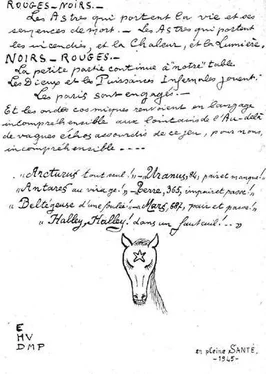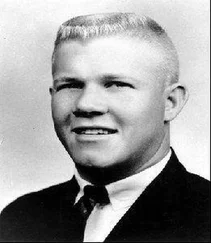This conviction—the first to stick against the young politician—led to a temporary loss of his voting rights, which, in French law, required a mandatory removal from office. And so once again, before the inevitable occurred, Petiot resigned. The political career of the “New Clemenceau” was over. Another phase was about to begin.
BACK at headquarters, after a beer in a brasserie on place Dauphine and a quick telephone call to his wife, Commissaire Massu sent a couple of inspectors to check out Georgette Petiot’s claims. No one had seen her at 52 rue de Reuilly, but this did not necessarily discredit her statement, as she had been trying to hide and none of the twenty-one residents in the building knew her. Even the concierge barely recognized her.
Another detective, Inspector Hernis, checked out the Hôtel Alicot at 207 rue de Bercy, where she claimed to have eaten before leaving for Auxerre. The owner, Henri Alicot, confirmed that Madame Petiot had arrived at his restaurant, as she had claimed, on the morning of the thirteenth, looking bewildered and exhausted. He could also confirm that she had spent the day there, distraught about the news.
It was not possible, she had said, that her husband, “who is so good to me,” could have done those things reported in the newspapers. In the seventeen years of marriage, Georgette Petiot added, she had not once seen him angry. Her immediate plans were to travel to Auxerre to be with her son. Madame Petiot had napped in one of the rooms, but declined food until Alicot had convinced her to eat a bowl of soup before leaving for the 5:20 train to Auxerre. Clearly she had feared being arrested.
Perhaps the restaurateur’s most interesting revelation concerned not the suspect’s wife, but his brother. According to Alicot, Maurice Petiot came to Paris almost every week for business, usually arriving on a Wednesday and staying at his hotel until Saturday. Alicot claimed not to have seen him since the previous month, but he could date the event because it had been so peculiar.
During his stay February 19–22, 1944, Alicot recalled, a truck driver and a workman had appeared in his hotel lobby to deliver a message to Maurice. Their truck, which contained a delivery for the younger Petiot, had broken down at the corner of Boulevard Saint-Michel and Boulevard Saint-Germain, and the two men had been forced to leave it there. What particularly struck Alicot, however, was not the message, though he did wonder why they would abandon a truck loaded with goods. It was how frightened the men looked when they relayed the news and then how quickly they departed afterward.
9.
EVASION
DR. PETIOT WAS A CLEVER MAN.
—René Piédelièvre
EXAMINING the black satin dress found in the basement of rue Le Sueur, Massu’s men had identified a possible victim. Detectives had contacted the Marseille designer listed on the fashion tag, Silvy-Rosa, whose real name was Sylvie Givaudan, and she remembered the dress. Givaudan had made it about three and a half years before and sold it to a woman named Paulette from a nearby brothel, whom she described as young and beautiful.
The Marseille police department was able to provide more information about this woman. Her real name was Joséphine Aimée Grippay. She had been given the name Paulette by a pimp who thought “Joséphine” sounded old-fashioned. “It was good one hundred years ago,” he had reportedly told her, “[but] men like easy names to remember.” Grippay had gained a number of other sobriquets, including “La Chinoise” for her long black hair, high cheekbones, and other facial features deemed Asian, though she was actually from Corsica.
Born January 7, 1917, in the port of Bonifacio (Bunifaziu), to a Corsican mother and a Breton father, Grippay had begun working in a brothel in Ajaccio before reaching Marseille, where she settled into an upscale brothel on rue Venture. Grippay soon made connections with many figures in the underworld, including, most prominently, Joseph Piereschi, known variously as “Joseph le Marseillais,” Dionisi, or Zé. By the time World War II broke out, Piereschi had been sentenced to prison a number of times, mostly for petty theft, though there was one murder charge and his participation in a train robbery that netted 983,000 francs. During the German Occupation, he started running a brothel for Nazi officers at Aire-sur-la-Lys. Eventually accused of defrauding German authorities, Piereschi fled, bringing Paulette Grippay with him. They worked their way north. Grippay had been in Paris just over one year when the police found her dress in Dr. Petiot’s basement.
How had Petiot come to know her? Was he one of her clients, or was she one of his? Rue Caumartin, after all, was located in the middle of a lively district full of nightclubs, bars, and brothels.
Not far away, on rue Provence, tucked into a discreet building with closed white shutters, was the One Two Two. The seven-story brothel, once the home of Napoleon’s marshal Joachim Murat, catered to an exclusive clientele that included royalty, statesmen, film stars, and eventually, many tourists. Each room upstairs projected a different theme. There was an Orient Express suite, a luxurious ocean liner cabin, and a Cloth of Gold Room inspired by the famous celebration by King Francis I and King Henry VIII in the summer of 1520. The Arctic igloo came with reindeer antlers and a polar bear rug, and the “sunny farmhouse” was surrounded by a white picket fence with a mock hayloft above the bed. Two rooms were covered completely with mirrors. The top floors contained the more risqué rooms, including the popular torture chamber, with its whips, chains, handcuffs, and leather thongs.
Since his arrival in Paris eleven years before, Petiot had drawn many clients from this environment. He had also attracted women from far less luxurious brothels, and many of them, like Jeannette Gaul, were outside the system of regulation altogether. Antonie Marguerite Bella, a thirty-six-year-old former chambermaid who became addicted to heroin and then worked as an unlicensed street walker, often visited his practice. She had no difficulty whatsoever in obtaining drugs from Dr. Petiot, she told Inspector Jean Prigent when he questioned her in prison. She had been referred to his practice by a friend in the same line of business, who consulted the doctor for “the same reasons” and, she added, found the “same satisfaction.”
There was no shortage of witnesses ready to testify about Petiot’s clientele, which seemed overwhelmingly female, with many of them addicted to morphine, heroin, or cocaine. As one patient later put it, Dr. Petiot was known to “nearly all the drug addicts of Montmartre.” And if these women could not pay his rates, Petiot was not averse to cutting a deal or trading services. The physician credited these women with teaching him invaluable lessons, not least in how to impose his will on other people. “It is through them that you learn to dominate,” Petiot said, calling prostitutes “the harems which make the great conquerors.”
One unidentified prostitute and client later told a reporter of her experiences with Petiot. “We were all a little afraid of him. He always asked for tricks that we did not like or sometimes that we did not know. Then, he would explain it to us with a funny laugh.” He was often rough and liked to bite or “pinch nipples with all his might.” Some prostitutes, like Marguerite la Poupée or Annette “Chouchou,” frequented his clinic for ointments. Petiot had a reputation for treating venereal diseases, particularly gonorrhea and syphilis, the latter being an especially difficult and lengthy procedure. There was, in short, no lack of opportunities for Petiot to gain insight and influence into the Parisian underworld.
Читать дальше












